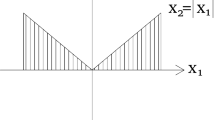Abstract
Certain types of necessary optimality conditions for mathematical programming problems are equivalent to corresponding regularity conditions on the constraint set. For any problem, a certain natural optimality condition, dependent upon the particular constraint set, is always satisfied. This condition can be strengthened in numerous ways by invoking appropriate regularity assumptions on the constraint set. Results are presented for Euclidean spaces and some extensions to Banach spaces are given.
Similar content being viewed by others
References
J. Abadie, “Generalization of the Wolfe reduced gradient method to the case of nonlinear constraints,” in:Optimization, Ed. R. Fletcher (Academic Press, 1969).
J. Abadie, “On the Kuhn-Tucker theorem,” in:Nonlinear Programming, Ed. J. Abadie (North-Holland Publishing Co., Amsterdam, 1967).
K. Arrow, L. Hurwicz and H. Uzawa, “Constraint qualifications in maximization problems,”Naval Research Logistics Quarterly 8 (1961) 175–191.
M. Canon, C. Cullum and E. Polak, “Constrained minimization problems in finite-dimensional spaces,”SIAM Journal on Control 4 (1966) 528–547.
A. Charnes and W. Cooper,Management models and industrial applications of linear programming (John Wiley and Sons, New York, 1961).
A. Colville, “A comparative study of nonlinear programming codes,” IBM, New York Scientific Center Report 320-2949, NYSC, IBM, 410 East 62nd St., New York, New York, 10021.
R. Cottle, “A theorem of Fritz John in mathematical programming,” RAND Memorandum RM-3858-PR (October 1963).
J. Evans, “On constraint qualifications in nonlinear programming,”Naval Research Logistics Quarterly, to appear.
J. Farkas, “Über die Theorie der einfachen Ungleichungen,”Zeitschrift für die reine und angewandte Mathematik 124 (1901) 1–27.
R. Fletcher, “A class of methods for nonlinear programming with termination and convergence properties,”Integer and Nonlinear Programming, Ed. J. Abadie (North-Holland Company, Amsterdam, 1970).
F. John, “Extremum problems with inequalities as subsidiary conditions, Studies and Essays,”Courant Anniversary Volume (Interscience, New York, 1948).
D. Gale,The theory of linear economic models (McGraw-Hill Book Company, Inc., New York, 1960) p. 44.
F. Gould and J. Tolle, “A necessary and sufficient qualification for constrained optimization,”SIAM Journal on Applied Mathematìcs 20 (1971) 164–172.
F. Gould and J. Tolle, “Optimality conditions and constraints qualifications in Banach space,” Institute of Statistics Mimeo Series No. 707, Department of Statistics, University of North Carolina, Chapel Hill, N.C. 27514.
M. Guignard, “Generalized Kuhn-Tucker conditions for mathematical programming problems in a Banach space,”SIAM Journal on Control 7 (1969) 232–241.
M. Guignard, “Gahiers du Bureau Universitaire De Recherche Operationnclle, Cahier No. 14, “Conditions d'Optimalité et Dualité en Programmation Mathématique, Paris, 1970. (Available from Bureau Universitaire de Statistique de l'Université de Paris, Tour 45 55, 9, Quai Saint-Bernard, Paris Ve).
G. Hadley,Nonlinear and dynamic programming (Addison-Wesley, Reading, Massachusetts, 1964).
L. Hurwicz, “Programming in linear spaces,” in:Studies in linear and nonlinear programming, Eds. K. Arrow, L. Hurwicz and H. Uzawa (Stanford University Press, Stanford, California, 1958).
S. Karlin,Mathematical methods and theory in games, programming, and economics (Addison-Wesley, Reading, Massachusetts, 1959).
H. Kuhn and A. Tucker,Nonlinear programming, Proceedings of the Second Berkeley Symposium on Mathematical Statistics and Probability, Ed. J. Neyman (University of California Press, Berkeley, 1951) pp. 481–492.
O. Mangasarian,Nonlinear programming (McGraw-Hill Book Co., New York, 1969).
O. Mangasarian and S. Fromovitz, “The Fritz John necessary optimality conditions in the presence of equality and inequality constraints,”Journal of Mathematical Analysis and Applications 17 (1967) 37–47.
K. Ritter, “Optimization theory in linear spaces,”Mathematische Annalen 184 (1970) 133–154.
M. Simonnard,Programmation lineaire (Dunod, Paris, 1962) p. 388.
M. Slater, “Lagrange multipliers revisited, A contribution to nonlinear programming,” Cowles Commission Paper, Math. 403 (1950).
P. Varaiya, “Nonlinear programming in Banach space,”SIAM Journal on Applied Mathematics 15 (1967) 284–293.
W. Zangwill,Nonlinear programming, A unified approach (Prentice Hall Publishers, Englewood Cliffs, N.J., 1969).
S. Zlobec, “Asymptotic Kuhn-Tucker conditions for mathematical programming problems in a Banach space,”SIAM Journal on Control 8 (1970) 505–512.
Author information
Authors and Affiliations
Additional information
This work was supported in part by the Office of Naval Research, Contract No. N00014-67-A-0321-0003 (NR-047-095).
Rights and permissions
About this article
Cite this article
Gould, F.J., Tolle, J.W. Geometry of optimality conditions and constraint qualifications. Mathematical Programming 2, 1–18 (1972). https://doi.org/10.1007/BF01584534
Received:
Revised:
Issue Date:
DOI: https://doi.org/10.1007/BF01584534



